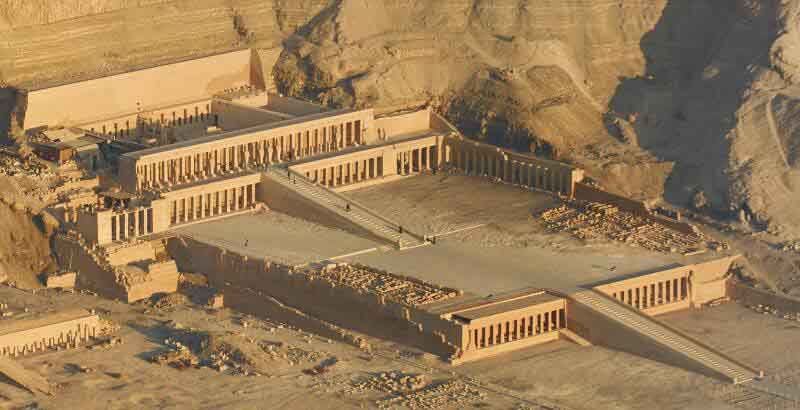
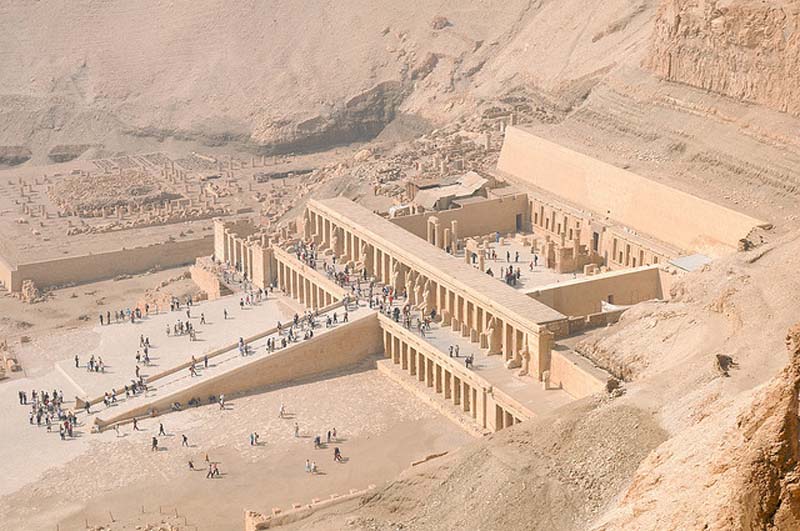
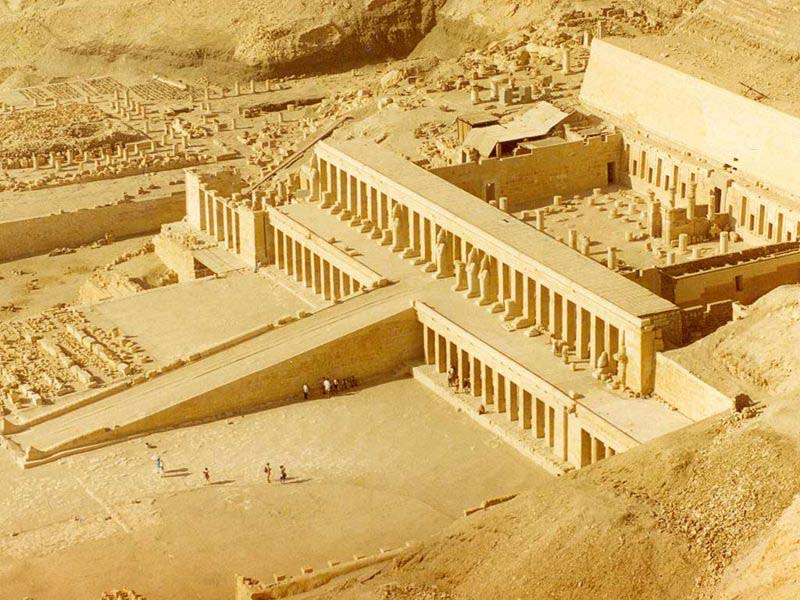
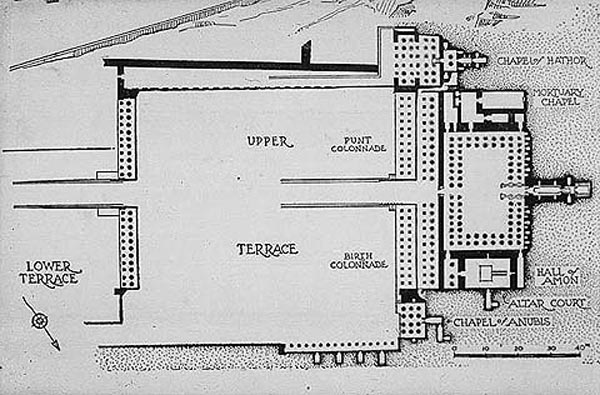
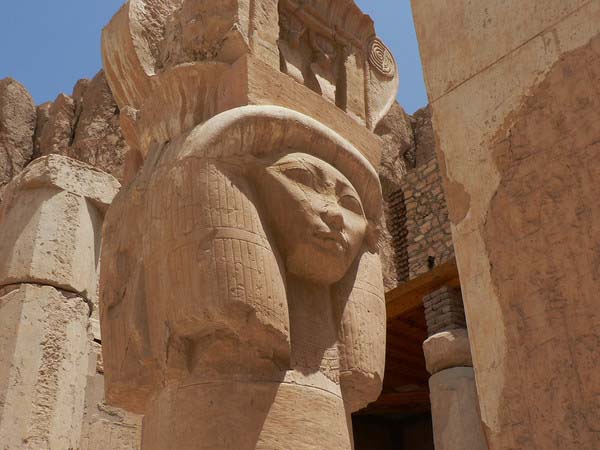





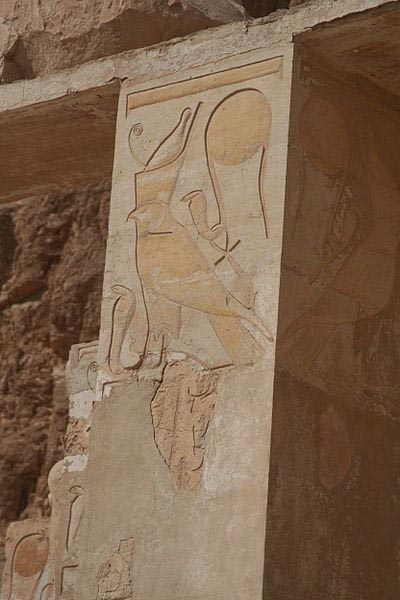
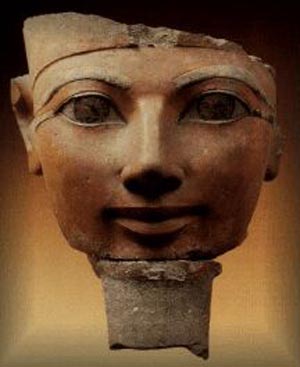
Following the tradition of many pharaohs, the masterpiece of Hatshepsut's building projects was her mortuary temple. She built hers in a complex at Deir el-Bahri. It was designed and implemented by Senemut at a site on the West Bank of the Nile River near the entrance to what now is called the Valley of the Kings because of all the pharaohs who later chose to associate their complexes with the grandeur of hers. Her buildings were the first grand ones planned for that location.
The focal point was the Djeser-Djeseru or "the Sublime of Sublimes", a colonnaded structure of perfect harmony nearly one thousand years before the Parthenon was built. Djeser-Djeseru sits atop a series of terraces that once were graced with lush gardens. Djeser-Djeseru is built into a cliff face that rises sharply above it. Djeser-Djeseru and the other buildings of Hatshepsut's Deir el-Bahri complex are considered to be significant advances in architecture. Another one of her great accomplishments is the Hatshepsut needle - also known as the granite obelisks.
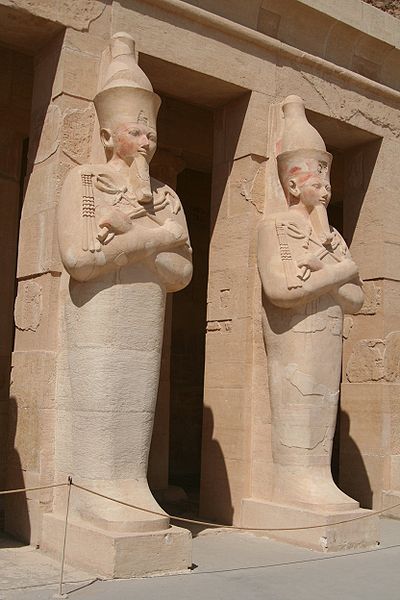
Osirian statues of Hatshepsut at her tomb, one stood at each pillar of the extensive structure, note the mummification shroud enclosing the lower body and legs as well as the crook and flail associated with Osiris - Deir el-Bahri
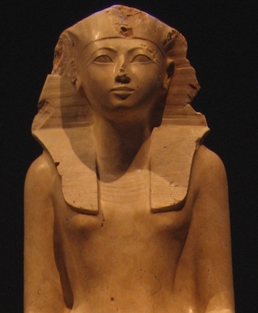
Hatshepsut assumed all of the regalia and symbols of the pharaonic office in official representations: the Khat head cloth, topped with the uraeus, the traditional false beard, and shendyt kilt. Many existing statues alternatively show her in typically feminine attire as well as those that depict her in the royal ceremonial attire. Statues portraying Sobekneferu also combine elements of traditional male and female iconography and, by tradition, may have served as inspiration for these works commissioned by Hatshepsut. After this period of transition ended, however, most formal depictions of Hatshepsut as pharaoh showed her in the royal attire, with all of the pharaonic regalia.
At her mortuary temple, in Osirian statues that regaled the transportation of the pharaoh to the world of the dead, the symbols of the pharaoh as the deity Osiris were the reason for the attire and they were much more important to be displayed traditionally, her breasts are obscured behind her crossed arms holding the regal staffs of the two kingdoms she ruled. This became a pointed concern among writers who sought reasons for the generic style of the shrouded statues and led to misinterpretations.
Understanding of the religious symbolism was required to interpret the statues correctly. Interpretations by these early scholars varied and often, were baseless conjectures of their own contemporary values. The possible reasons for her breasts not being emphasized in the most formal statues were debated among some early Egyptologists, who failed to understand the ritual religious symbolism, to take into account the fact that many women and goddesses portrayed in ancient Egyptian art often lack delineation of breasts, and that the physical aspect of the gender of pharaohs was never stressed in the art. With few exceptions, subjects were idealized.
Modern scholars, however, have theorized that by assuming the typical symbols of pharaonic power, Hatshepsut was asserting her claim to be the sovereign rather than a "King's Great Wife" or queen consort. The gender of pharaohs was never stressed in official depictions; even the men were depicted with the highly stylized false beard associated with their position in the society.
Moreover, the Osirian statues of Hatshepsut - as with other pharaohs - depict the dead pharaoh as Osiris, with the body and regalia of that deity. All of the statues of Hatshepsut at her tomb follow that tradition. The promise of resurrection after death was a tenet of the cult of Osiris. Since many statues of Hatshepsut depicted in this fashion have been put on display in museums and those images have been widely published, viewers who lack an understanding of the religious significance of these depictions have been misled. Aside from the face depicting Hatshepsut, these statues closely resemble those of other kings as Osiris, following religious traditions.
Most of the official statues commissioned of Hatshepsut show her less symbolically and more naturally, as a woman in typical dresses of the nobility of her day. Notably, even after assuming the formal regalia, Hatshepsut still described herself as a beautiful woman, often as the most beautiful of women, and although she assumed almost all of her father's titles, she declined to take the title "The Strong Bull" (the full title being, The Strong Bull of his Mother), which tied the pharaoh to the goddesses Isis, the throne, and Hathor, (the cow who gave birth to and protected the pharaohs) - by being her son sitting on her throne - an unnecessary title for her, since Hatshepsut became allied with the goddesses, herself, which no male pharaoh could. Rather than the strong bull, Hatshepsut, having served as a very successful warrior during the early portion of her reign as pharaoh, associated herself with the lioness image of Sekhmet, the major war deity in the Egyptian pantheon.
Religious concepts were tied into all of these symbols and titles. By the time of Hatshepsut's reign, the merger of some aspects of these two goddesses provided that they would both have given birth to, and were the protectors of, the pharaohs. They became interchangeable at times. Hatshepsut also traced her lineage to Mut, a primal mother goddess of the Egyptian pantheon, which gave her another ancestor who was a deity as well as her father and grandfathers, pharaohs who would have become deified upon death.
While Hatshepsut was depicted in official art wearing regalia of a pharaoh, such as the false beard that male pharaohs also wore, it is most unlikely that she ever wore such ceremonial decorations, just as it is unlikely that the male pharaohs did. Statues such as those at the Metropolitan Museum of Art, depicting her seated wearing a tight-fitting dress and the nemes crown, are thought to be a more accurate representation of how she would have presented herself at court.
As a notable exception, only one male pharaoh abandoned the rigid symbolic depiction that had become the style of the most official artwork representing the ruler, Pharaoh Amenhotep IV (later Akhenaten) of the same eighteenth dynasty, whose wife, Nefertiti, also may have ruled in her own right following the death of her husband.
One of the most famous examples of the legends about Hatshepsut is a myth about her birth. In this myth, Amun goes to Ahmose in the form of Thutmose I and awakens her with pleasant odors. At this point Amun places the ankh, a symbol of life, to Ahmose's nose, and Hatshepsut is conceived by Ahmose. Khnum, the god who forms the bodies of human children, is then instructed to create a body and ka, or corporal presence/life force, for Hatshepsut. Heket, the goddess of life and fertility, and Khnum then lead Ahmose along to a lioness' bed where she gives birth to Hatshepsut. Reliefs depicting each step in these events are at Karnak and in her mortuary temple.
Hatshepsut claimed that she was her father's intended heir and that he made her the heir apparent of Egypt. Almost all scholars today view this as historical revisionism, or prolepsis, on Hatshepsut's part since it was Thutmose II - a son of Thutmose I by Mutnofret - who was her father's heir. Moreover, Thutmose I could not have foreseen that his daughter Hatshepsut would outlive his son within his own lifetime. Thutmose II soon married Hatshepsut and the latter became both his senior royal wife and the most powerful woman at court.
Throughout the temple, statues and sphinxes of the queen proliferated. Many of them have been reconstructed, with patience and ingenuity, from the thousands of smashed fragments found by the excavators; some are now in the Cairo Museum, and others in the Metropolitan Museum of Art, New York City.
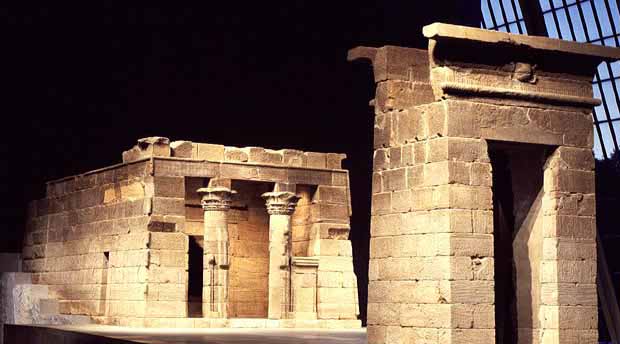
Metropolitan Museum of Art, New York